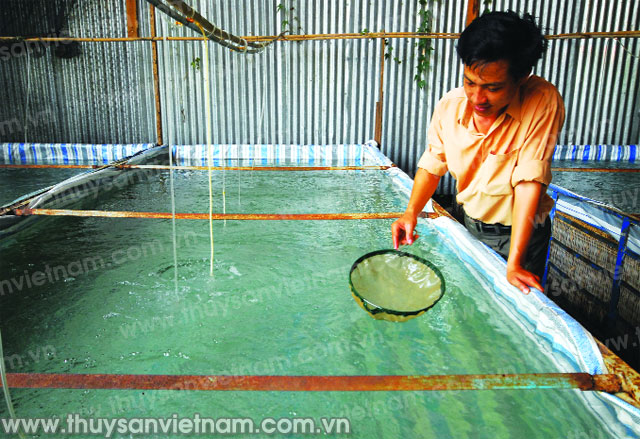Many hold that the first step for successfully restructuring Vietnam’s Tra fish industry is to improve the Tra fry quality and to apply advanced farming technology.
Tra fry quality a concern
Tra fries mainly come from Dong Thap, An Giang and Tien Giang provinces and Can Tho city in the Mekong delta with sufficient quantity but low quality. The price has dropped and fluctuated recently, so incubation and cultivation facilities have not been upsized yet. Scattered production makes it difficult to control the quality.
Most of the Tra fries have been produced and provided spontaneously in the delta in the absence of a comprehensive development. The quality of Tra fries has seen a fall over the past few years (high rates of deformity and survival, undergrowth, vulnerability to diseases). Besides, there is no difference in the prices of genetically improved and local baby fish. Farmers, therefore, do hesitate in investing into proper incubation of the genetically improved baby fish. Most of the facilities ignore the standard production system for immediate benefit (such as fatten performance, gonadotropic hormone abuse, unselected fish broodstock, unsuitable spawning size…)
Incomplete farming technologies
It is quite normal for every farming household to find tens of fish dead in the intensive farming ponds on a daily basis. However in these years, farmers built deeper ponds with a higher stocking density while lower-quality fries and outdated farming technologies have caused higher rates of mortality, diseases and antibiotic use. As a result, the production cost rose while the food hygiene and safety were poorly controlled.
Farmer Nguyen Van Doi in Tan Phong commune, Cai Lay district (Tien Giang province) said that the price of veterinary medicine for Tra fish is now topping 1,000 dong per kilogram against 600 dong a few years ago. Farmers who are short of experience and technology suffer heavy losses as their production cost rose to 23,000 – 24,000 dong per kilogram.
Many diseases cause damage to Tra fish, but ways to prevent and cure them remain an unanswered question to scientists, and this hikes production cost for incubation and veterinary medicine while lowering the effectiveness of feed usage.

Tra fry quality management needs to be tightened – Photo: Le Hoang
Vice President of the Tien Giang Fisheries Society Phan Huu Hoi said intensive Tra fish farmers often buy cheap fries with low traceability and without careful examination. Fish are stocked at a high density, such as 100 per square meter, with a calculation in mind that some of them will die and this will reach a suitable rate when harvest comes. The ponds, as a result, become unmanageable and environment polluted, causing diseases outbreak, leading to a high production cost. Almost all farmers do not build treating ponds, and disposed water directly goes to the surface sources, bringing the pathogen to the ponds.
First step
Low quality of baby Tra fish and outdated technology push up the farming cost, reduce the efficiency, and cause negative impact on the whole production chain and sustainability of Vietnam’s Tra fish industry. Truong Thi Le Khanh, Chairwoman of the Board of Directors of Vinh Hoan JSC, one of the leading Tra fish producers and exporters, said improvement of the quality of fries and advanced technology application is the first step in Tra fish restructuring.
In her opinion, the implementation of a project to improve the quality of the parent fish by means of genetics selection by the Ministry of Agriculture and Rural Development (MARD) is extremely necessary, and this must be carried out on a long-term basis, not in a short-term manner as it is now. The quality and traceability of fries are hard to control as they are bought from various farmers and facilities. Provincial authorities should reserve some land, build facilities, and work out policies on rental fee exemption and tax preference to encourage skillful farmers to rent for fingerling nurseries. As a result, enterprises can buy qualified fries without antibiotics at reasonable prices and farmers get benefits from their work. This is also a basis for enterprises to advertise the safe nursery system. An other noteworthy point is that the standard for fries has not been set up by the Government.
MARD should work with enterprises to increase the farming density to over 40 fries per square meters and apply advanced technologies to increase the yield and effectiveness. Meanwhile the feed quality and cultivation technique should be improved in order to reduce the FCR to 0.2 (under 0.2 kilogram of feed for one kilogram of fish). As much as 100 million USD will be save should the FCR reaches 0.2.
Associate Professor and Doctor Do Thi Thanh Huong (Aquaculture Faculty of Can Tho University) said that intensive ponds now stand at 4 – 4.5m in depth with a density of around 100 fish per square metre, and yet the water change is done partly in accordance with tidal changes. Tra fish live mainly in the surface water (0.5m), that is why the oxygen deficiency at rush hour (2 – 9h) or at deeper water layers is unavoidable. Once the dissolved oxygen level is low, fish must swim up and get oxygen at the surface water, where they lose their energy and growth rate. Farmers, therefore, should install air bubbling systems in the water increase the oxygen level, reduce the toxic gas discharge, energy waste and stress, improve growth rate, increase farming density, yield and feed efficiency.
|
>> In 2010 and 2011, Research Institute for Aquaculture No.2 provided the Mekong Delta localities with 105,423 selected Tra fish, 101, 000 of which were produced in a project on the transfer the production technology of Tra fish with high genetic quality. After some time, 82,131 fish were found surviving, growing faster, and able for spawning. Mature fish produced big eggs, with a fertilization rate of 80%, eggs making up 8% of the body weight (1.1 million fish are produced from one kilogram of egg). |